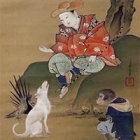平成館 企画展示室
2016年1月2日(土) ~ 2016年2月14日(日)
江戸幕府の御用絵師でやまと絵の分野を主に担当していた住吉広守(すみよしひろもり/1705~77)の弟子板谷慶舟広当(けいしゅうひろまさ)は、病にあった広守に代わって安永2年(1773)に住吉家を継ぎました。天明元年(1781)には、長男の広行に住吉家の家督を譲って隠居しましたが、翌年その仕事ぶりを惜しんだ幕府により、改めて召しだされ、御用絵師としての板谷家がはじまりました。
当館では、平成21年度に板谷家の御子孫より「板谷家伝来資料」として同家に伝わる粉本(絵画制作のための手本や模写)・下絵類のご寄贈をいただき、平成23年度から科学研究費補助金により、「板谷家伝来資料」と板谷派関連作品の調査を行ってまいりました。平成23年には、「板谷家伝来資料」に館蔵の板谷派作品を加えた特集陳列をおこないました。
今回は、調査によって明らかとなった初代広当(1729~97)、2代広長(ひろなが/1760~1814)、3代広隆(ひろたか/1786~1831)、5代弘延(ひろのぶ/1820~59)、7代広永(ひろなが/1871~1949)の板谷家歴代と住吉家5代広行(ひろゆき/1754~1811)の作品をご所蔵者のご協力により紹介するとともに、板谷家における絵画の制作活動と関わりのある下絵類を展示いたします。
※ 本展示は、平成23~27年度科学研究費補助金(基盤研究A)「板谷家を中心とした江戸幕府御用絵師に関する総合的研究」(課題番号 23242013)の研究成果です。

